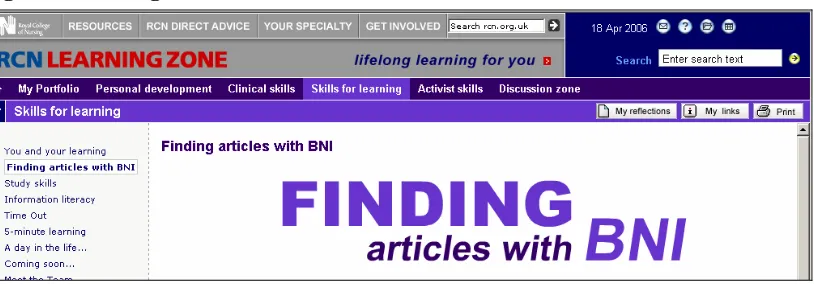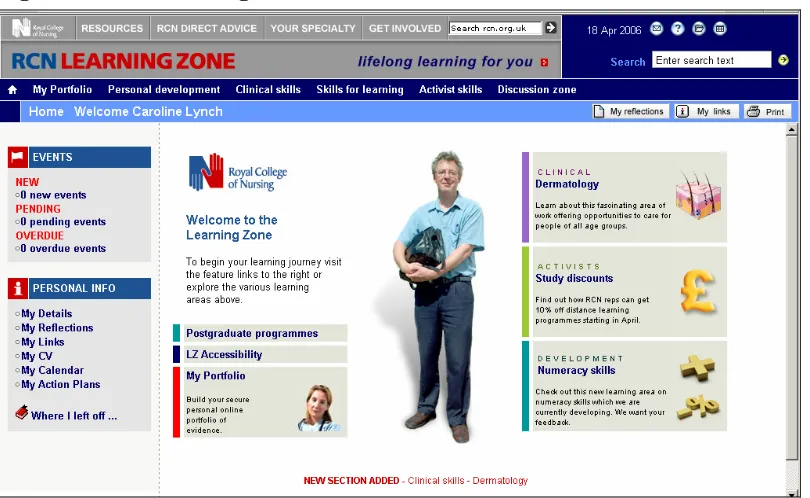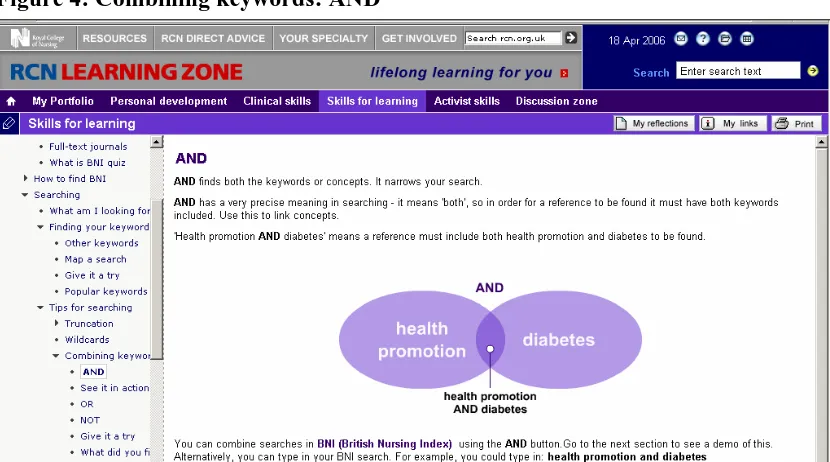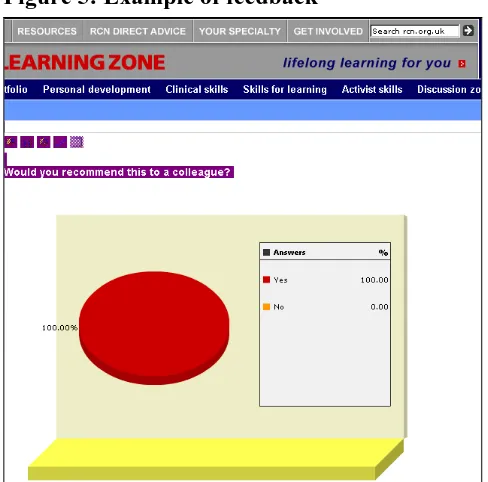ISSN 1750-5968
Volume 1 Issue 1
January 2007
Article from practice
Lynch, C. and Perrett, A. (2007) “Online information literacy learning for nurses: exploration
of an RCN learning area.” Journal of information literacy, 1(1), 43-48.
Copyright for the article content resides with the authors, and copyright for the publication
layout resides with the Chartered Institute of Library and Information Professionals,
Information Literacy Group. These Copyright holders have agreed that this article should be
available on Open Access.
“By 'open access' to this literature, we mean its free availability on the public internet, permitting any users to read, download, copy, distribute, print, search, or link to the full texts of these articles, crawl them for indexing, pass them as data to software, or use them for any other lawful purpose, without financial, legal, or technical barriers other than those inseparable from gaining access to the internet itself. The only constraint on reproduction and distribution, and the only role for copyright in this domain, should be to give authors control over the integrity of their work and the right to be properly acknowledged and cited.”
Online information literacy learning for nurses: exploration of
an RCN learning area
Caroline Lynch, Information Services Assistant Librarian, Royal College of Nursing, London,
UK. Email: caroline.lynch@rcn.org.uk
Angela Perrett, Library and Information Services Manager, Royal College of Nursing,
Cardiff, UK. Email: angela.perrett@rcn.org.uk
Abstract
This article explores the development of an online learning area including context and process of the development. Key features of the learning area are outlined. An analysis of the information needs of nurses highlighted a demand for information literacy training. The development of the learning area was a collaborative process involving library staff and lifelong learning staff. The learning area uses a variety of techniques to appeal to a range of learning styles. Feedback about the learning area has been obtained and ongoing development of the learning area is planned.
Keywords
Information Literacy; Nursing; Online learning
1. Introduction
1.1 Background and scope
The Royal College of Nursing (RCN) is the largest professional association and union of nursing staff and students in the UK. It has a diverse membership of over 390,000 people, including nurses, student nurses, and health care support workers. Library and Information Services (LIS) are a key part of the organisation. The RCN has four libraries across the UK and a successful e-library.
This article explores the development of an online learning area aimed at RCN members: Finding articles with BNI. This information literacy learning area looks at how to approach a literature search using British Nursing Index (BNI), which is a key nursing database.
We are the authors of the learning area. We were both involved in providing information literacy training for members, and from 2004 onwards began to work together to develop an online learning area. We wanted to offer our members an opportunity to develop their information literacy skills at a time that suited them, and without travelling to an RCN library.
Figure 1: Finding articles with BNI
1.2 RCN information literacy learning
The RCN has a network of union learning representatives. These are RCN members who are accredited union representatives and support the learning needs of other members in their workplace. LIS provide support and education for the learning representatives, who then cascade training to other members. Searching the BNI database is an important part of this. A paper based guide to searching BNI, developed by Lynch, is available from all RCN libraries and through our website (as a Microsoft Word document).
In 2004 the RCN undertook a UK wide survey to find out what information nurses, health visitors, midwives and health care assistants needed to support their practice and lifelong learning. 1,715 questionnaires were returned. This makes this exercise one of the largest ever undertaken. The survey found a high demand for information skills learning (Royal College of Nursing, 2005):
• 44% of respondents felt they would benefit from training in basic information-searching skills • 74% of respondents felt they would benefit from training in advanced information-searching skills
1.3 RCN e-library
The RCN e-library was launched in 2001. It offers RCN members a range of information resources including a selection of nursing e-journals, e-books, and databases. Members log into the RCN website (www.rcn.org.uk) with their RCN membership number and can then access these resources without any further passwords.
BNI is one of the key resources available in the RCN e-library. This database is produced by the Royal College of Nursing, Bournemouth University and Poole and Salisbury NHS Trusts. It covers nursing, midwifery, community health care and subjects of interest to nurses, providing references and abstracts to articles from all the major British nursing and midwifery journals and a selection of English language international journals. We offer BNI on the Silverplatter platform. It includes links to the e-journals we make available to members and is used by our members on average 11,000 times per month (database logins).
2. LIS development of the RCN Learning zone
2.1 RCN Learning Zone
The RCN Learning Zone was launched on the RCN website in 2002 (see Figure 2). It offers a range of learning areas aimed at the busy nurse. Content is structured into bite-sized chunks which enable learners to dip in and out as and when they need. Most chunks can be completed in 15 to 20 minutes and learners can bookmark where they left off and return to it later. Bite-sized chunks allow learning to be built up gradually.
Figure 2: RCN Learning Zone
An early version of the BNI learning area was available on the Learning Zone from 2002, but it was not interactive and was similar to the printed guide mentioned above. We decided to develop a new interactive learning area which would be based around searching BNI for information and would also develop skills and literacies which could be applied elsewhere.
2.2 Development of the learning area
Initial consultation indicated support from LIS staff and Lifelong Learning Team staff for the development of an interactive learning area. A literature search was undertaken to identify examples of good practice in web based learning. We then developed an outline for the learning area, which described every element within it. We ensured there would be a mixture of interactive content throughout. A creative designer commented on the outline and suggested alternatives to some interactive elements.
The outline for the learning area was agreed by a cross-departmental group of RCN staff in July 2004. The group included representatives from all four RCN libraries, the Quality Improvement Programme Information Service and the Lifelong Learning Team.
Writing of the learning area began in earnest in October 2004. We were the main authors for the learning area, with Lynch writing the content and Perrett commenting on each section, providing an ongoing review process during the content development. A Senior Lifelong Learning Fellow from the Lifelong Learning Team supported us and offered comments and suggestions, and the creative designer was involved throughout in creating some of the interactive elements e.g. flash demos, animation.
There was a final external content review of the learning area once it was complete. This looked at the accuracy, quality, and logical flow of the content. Based on the reviewers’ comments some amendments were made. The learning area was launched in July 2005. The development of the area had taken over a year and was a very rewarding, but time consuming process.
2.3 Overview of the learning area
The Finding articles with BNI learning area is located within the Skills for learning section of the RCN Learning Zone which also includes the following learning areas: Study skills, Information literacy, You and your learning. The learning outcome for the area is:
“By the end of this learning opportunity you will be able to undertake a search for journal articles using BNI and print out articles available through the RCN online journals service.”
It is aimed at beginners and is designed to be intuitive, simple and fun. It is interactive and includes animation, demos, reflection points, exercises and quizzes to appeal to a range of learning styles. Learners can link to the BNI database to try things out as they go along. Many of the skills and techniques learnt can also be applied to other databases.
A fictional case study is followed throughout the learning area. Pam is a nurse on a children's surgical ward. She is concerned that the children on her ward are not getting adequate post-operative pain relief. We follow her story throughout this learning and find out how she used BNI to meet this information need.
The learning area takes approximately 1.5 hours to complete. Some of the techniques used in the learning area are described below.
Rollover
Rollovers are used for exploring BNI screens and showing the functions of different buttons. Messages pop up as learners explore the screen with their mouse.
Animation and demos
Flash demos show how to undertake particular activities, e.g. how to view results in BNI. Animation is also used to explain some ideas visually, e.g. Boolean logic, identifying keywords.
Figure 4: Combining keywords: AND
Some of the sections within the learning area are described below.
What do I already know?
Learners can use this pre-assessment quiz to assess their existing knowledge and to discover which sections of the learning area might be most useful.
Give it a try
This section offers opportunities for learners to link to BNI and try the techniques for themselves. There are set exercises/activities for them to undertake within BNI to encourage them to use the database while using the learning area.
Reflection
Suggested reflection points encourage learners to consider how they can apply the learning to their own situation. There is also an opportunity to record this reflection in the online portfolio available on the Learning Zone.
“What have I learnt?” quiz
These multiple choice quizzes occur throughout the learning area and allow users to evaluate their learning. Feedback is offered for both correct and incorrect answers.
A bit of fun
A crossword and a wordsearch relating to BNI.
Feedback
3. Promotion, integration and evaluation
3.1 Promotion and integration
Work to promote the learning area is ongoing. We have led events for RCN library staff, RCN members and students and external health library staff to introduce them to the learning area. We led hands-on workshops at LILAC (Librarians' Information Literacy Annual Conference) 2006 and the Libraries for Nursing/ Information for the Management of Healthcare 2005 study day (E-learning and information literacy).
Work to integrate the learning area within our teaching plans is being undertaken this year. The main focus of this work will be to produce a range of learning materials to support both RCN staff and activists, who will be involved in training and promoting the BNI learning area e.g. online PowerPoint presentations for use by RCN union learning representatives.
Integration between the learning area and other parts of the RCN site is an area we want to develop but it is dependent upon some technical problems being resolved.
3.2 Evaluation
We have obtained informal verbal feedback from RCN library staff, RCN members and students, external health library staff at training sessions and workshops. There is also a Feedback page at the end of the learning area through which we have received further feedback from learners.
Figure 5: Example of feedback
Some of the comments from the online evaluation are:
“Took the fear out of my first attempt at on-line searching.” “Quizzes and word search helpful and good way of reflecting.”
“It was fun doing the wordsearch but not very valuable to me. However it will be very valuable to nurses who are not familiar with how to search for evidences to guide practice.”
Feedback from all sources has been positive. Specific suggestions for improvement have been noted and will be considered as part of a review of the learning area this year. In particular the learning area is generally felt to be too long so we will be considering how to address this. One possibility is to split it into two learning areas.
4. Conclusion
The knowledge we gained through the process will help inform future information literacy work. Particular learning points for us were the usefulness of involvement from the Senior Lifelong Learning Fellow and creative designer throughout the process and the significant time needed to develop the area. We also learned it is vital to keep the learning area to a manageable length.
Overall the learning area has been a successful in providing an interactive learning area for RCN members. We will continue to develop it to maintain its currency and to make improvements.
Further information
If you would like further information or a temporary password to access the Finding articles with BNI
learning area please contact us at the following addresses.
Caroline Lynch: Information Services Assistant Librarian, Royal College of Nursing, 20 Cavendish Square, London WIG ORN, UK. Tel. +44, (0)207 647 3611. Email: caroline.lynch@rcn.org.uk
Angela Perrett, Library and Information Services Manager, Royal College of Nursing, Ty Maeth, King George V Drive East, Cardiff CF14 4XZ, UK. Tel. +44 (0)29 2075 1373. Email: angela.perrett@rcn.org.uk
References
Allan, B. (2002). E-learning and teaching in library and information services. London: Facet.
Jordan, K. (2003). “E-information skills: investigating current developments in electronic information skills training within the library and information profession.” Libraries for nursing bulletin, 23(2), 19-23.
Royal College of Nursing. (2005) The information needs of nurses: summary report of an RCN survey.



